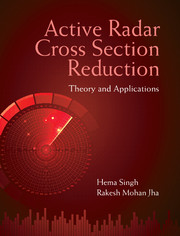Book contents
- Frontmatter
- Dedication
- Contents
- List of Tables
- List of Figures
- List of Abbreviations
- Preface
- Acknowledgements
- 1 Introduction to Radar Cross Section Reduction
- 2 RAM Analysis for Low-Observable Platforms
- 3 Radar Cross Section of Phased Antenna Arrays
- 4 Active RCS Reduction in Phased Arrays
- 5 Mutual Coupling Effects in Phased Arrays
- 6 RCS of Dipole Array Including Mutual Coupling Effects
- 7 Performance of Sidelobe Cancellers in Active RCSR
- 8 Emerging RCSR Techniques
- Epilogue
- Appendices
- List of Symbols
- Suggestions for Further Reading
- Author Index
- Subject Index
2 - RAM Analysis for Low-Observable Platforms
Published online by Cambridge University Press: 05 April 2015
- Frontmatter
- Dedication
- Contents
- List of Tables
- List of Figures
- List of Abbreviations
- Preface
- Acknowledgements
- 1 Introduction to Radar Cross Section Reduction
- 2 RAM Analysis for Low-Observable Platforms
- 3 Radar Cross Section of Phased Antenna Arrays
- 4 Active RCS Reduction in Phased Arrays
- 5 Mutual Coupling Effects in Phased Arrays
- 6 RCS of Dipole Array Including Mutual Coupling Effects
- 7 Performance of Sidelobe Cancellers in Active RCSR
- 8 Emerging RCSR Techniques
- Epilogue
- Appendices
- List of Symbols
- Suggestions for Further Reading
- Author Index
- Subject Index
Summary
Introduction
The electromagnetic (EM) wave propagation within a given material mainly depends on its constitutive parameters, viz. permittivity (ε), permeability (ε) and thickness of material. In macroscopic sense, these parameters describe the effects of induced electric and magnetic polarisations within the medium. These constitutive parameters can have either negative or positive values. The negative permittivity and permeability are known to be associated with the metamaterials (Veselago 1968). A metamaterial can be epsilon negative index (ENG) or mu negative index (MNG) or double negative index (DNG) materials (Shelby et al. 2001). Various analytical methods have been proposed for the plane wave analysis of EM propagation within the multilayered structures (Ziolkowski and Heyman 2001), (Kong 2002), (Cory and Zach 2004). The EM propagation within such materials exhibits negative refraction and other interesting propagation phenomena. The characteristic reflection/transmission behaviours of dielectric-metamaterial coatings have strategic applications towards the control of radar signatures of aerospace structures and, hence, low-observable platforms.
In this chapter, a systematic description of EM propagation through layered media is presented. These multilayered media include both dielectric–dielectric and dielectric-metamaterial media. The dielectric media is taken to be homogeneous. For a plane EM wave incident on planar layers having different dielectric and magnetic parameters, the reflected and transmitted fields are determined. The EM propagation within the layers is explained in terms of reflection/transmission from different types of media. This includes semi-infinite media, dielectric layers with finite thickness and lossy dielectric layers. The presence of absorption in a lossy medium is taken into account by the complex nature of wave numbers. The reflective behaviour of the multilayered media with respect to the frequency of the incident EM wave, thickness and constitutive parameters of the layers is discussed. A proper choice of design parameters would facilitate the design and development of radar-absorbing material (RAM) coatings.
EM propagation in classical multilayered media
In this section, the basic expressions for the impedance of multilayered medium, the Fresnel's coefficients for reflection and the transmission for parallel and perpendicular polarisations are discussed. The EM propagation is expressed in terms of these coefficients.
- Type
- Chapter
- Information
- Active Radar Cross Section ReductionTheory and Applications, pp. 15 - 64Publisher: Cambridge University PressPrint publication year: 2015



